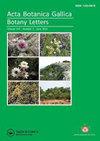Structural analysis of regeneration in tropical dense forest: combined effect of plot and spatial distribution patterns
引用次数: 2
Abstract
Abstract This study assessed the combined effect of the size and shape of inventory plots on the analysis of the density and diameter structure of saplings and juvenile trees. Thirty square plots of 400 m² were randomly laid out and each one was divided into 400 quadrats of 1 m². Stem number of recruits was recorded for all tree species and their diameter at breast height was measured in the quadrats. Seven types of subplots with different shapes and sizes were considered by grouping adjacent quadrats of 1 m². The Green index was used to assess the spatial distribution of regeneration and Weibull distribution was applied to model stem diameter distributions. Box–Cox transformations and weighted regression were used to model the relationship between the Green index, the plot patterns and the standard error of the estimation of the regeneration density. The same analyses were applied to model the relationship between the Green index, the plot patterns and the mean absolute error of the shape parameter of the Weibull distribution. The Green index and the plot size had a significant impact on the error of the regeneration density estimation. For clumped distribution of individuals, the plot shape had a significant impact on the error of their density estimation. As for stem diameter distribution, only the plot size had a significant effect on the mean absolute error of the stem diameter structure. The rectangular plots and square plots of 100 m² (14 m × 7 m and 10 m × 10 m) appeared more suitable for an effective structural analysis of woody species regeneration in the tropical dense forest for an aggregated distribution and a random distribution, respectively.热带密林更新的结构分析:样地与空间分布格局的联合效应
摘要本研究评价了调查样地的大小和形状对幼树和幼树密度和直径结构分析的综合影响。随机布置30个400 m²的方形地块,每个地块分为400个1 m²的样方。在样方中记录了所有树种的新枝茎数,并测量了其胸高直径。通过对相邻1 m²的样方进行分组,考虑了7种不同形状和大小的子样地。采用格林指数评价再生空间分布,采用威布尔分布模拟茎径分布。利用Box-Cox变换和加权回归对格林指数、样地模式和再生密度估计标准误差之间的关系进行建模。用同样的分析方法对格林指数、图型和威布尔分布形状参数的平均绝对误差之间的关系进行了建模。格林指数和样地大小对再生密度估计误差有显著影响。对于聚集分布的个体,样地形状对其密度估计误差有显著影响。茎径分布方面,只有样地大小对茎径结构的平均绝对误差有显著影响。100 m²矩形样地(14 m × 7 m)和10 m × 10 m方形样地(10 m × 10 m)分别表现为聚集分布和随机分布,更适合于热带密林木本物种更新的有效结构分析。
本文章由计算机程序翻译,如有差异,请以英文原文为准。
求助全文
约1分钟内获得全文
求助全文

 求助内容:
求助内容: 应助结果提醒方式:
应助结果提醒方式:


